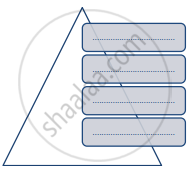Advertisements
Advertisements
Correct the incorrect pair and rewrite it.
Concept: Womens’ Movement in India
Explain the following concept with example.
Women’s empowerment
Concept: Womens’ Movement in India
Write differences.
Mobile addiction and Drug addiction.
Concept: Addiction (Substance, Internet, Mobile)
Read the following passage and answer the question based on it.
|
This is the real-life story of Rukmini Devi who lives in a small hut in Gaigotha Village in Wada Taluka of Palghar District in Maharashtra State. She belongs to the Warli tribe. Her husband is a marginal farmer who cultivates on two acres of land. They have two children, one daughter aged 10 years and a son aged 6 years. Both the children walk to school and back daily (located about 3 miles away). When cultivation season is over, (or if the rice crop is damaged due to heavy rains or pests) they face many hardships. A section of the crop is kept for their personal use, for the year. Tur Dal (lentil) is also grown in one small area, again for personal use. In a small backyard, they grow vegetables like chilies, cucumber, and bitter gourd (karela). During the off-season, both husband and wife go to the brick kilns (about 7 miles away) to do piece-rate work (That is, they get paid for each brick that they make). While the men earn Rs. 300 per day, the women earn Rs. 150-200. Rukmini Devi stated that they prefer to walk the 7 miles both ways because the bus fare is Rs. 35/- per head one way. They cannot afford it. |
- Identify any three problems that the family of Rukmini Devi has to face.
- Point out and discuss briefly, gender discrimination in this setting.
Concept: Passages
The sacred book of Jews is ______.
Concept: Ancient and Medieval India
Digambara and Shvetambara are sects in ______.
Concept: Ancient and Medieval India
The POCSO Act was passed in the year ______.
Concept: Post-independent India
The ‘Path of Action’ is called ______.
Concept: Ancient and Medieval India
Correct the incorrect pair and rewrite it.
Concept: Colonial Period
Identify the appropriate term from the given option in the box and rewrite it against the given statement.
|
B.S. GUHA, ANNIE BESANT, MIDDLE INDIAN REGION, NARCOTICS ANONYMOUS, MAKTAB, MADRASA |
- Established the Theosophical Society
- Oraon, Ho, Santhal
- Classified races into six types
- Elementary education
- Organisation that helps drug addicts
Concept: Colonial Period
Correct the underlined word and complete the statement.
Maktabs provide theological education.
Concept: Ancient and Medieval India
Correct the underlined word and complete the statement.
Jnana Marg, Bhakti Marg, Raja Marg and Karma Marg are the four ways to achieve wealth.
Concept: Ancient and Medieval India
Status of women in India during Early Vedic Period
Concept: Ancient and Medieval India
Write a short note.
Purusharthas
Concept: Ancient and Medieval India
Write differences.
Brahmacharyashram and Grihasthashram
Concept: Ancient and Medieval India
Write differences.
Buddhism and Jainism
Concept: Ancient and Medieval India
Explain the following concept with examples.
Ashramvyavastha
Concept: Ancient and Medieval India
Complete the concept map.

Concept: Ancient and Medieval India
Complete the concept map.
Caste hierarchy

Concept: Ancient and Medieval India
State whether the following statement are true or false with reason.
Religious teachings have no influence on human behaviour.
Concept: Ancient and Medieval India
